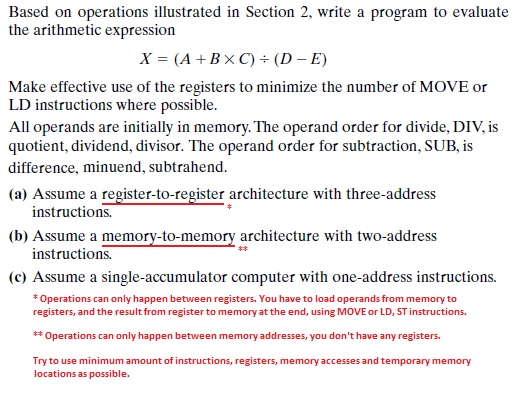Based on operations illustrated in Section 2, write a program to evaluate the arithmetic expression X = (A +B × C) ÷ (D – E) Make effective use of the registers to minimize the number of MOVE or LD instructions where possible. All operands are initially in memory. The operand order for divide, DIV, is quotient, dividend, divisor. The operand order for subtraction, SUB, is difference, minuend, subtrahend. (a) Assume a register-to-register architecture with three-address instructions. (b) Assume a memory-to-memory architecture with two-address instructions. (c) Assume a single-accumulator computer with one-address instructions. * Operations can only happen between registers. You have to load operands from memory to registers, and the result from register to memory at the end, using MOVE or LD, ST instructions. " Operations can only happen between memory addresses, you don't have any registers. Try to use minimum amount of instructions, registers, memory accesses and temporary memory locations as possible.
Based on operations illustrated in Section 2, write a program to evaluate the arithmetic expression X = (A +B × C) ÷ (D – E) Make effective use of the registers to minimize the number of MOVE or LD instructions where possible. All operands are initially in memory. The operand order for divide, DIV, is quotient, dividend, divisor. The operand order for subtraction, SUB, is difference, minuend, subtrahend. (a) Assume a register-to-register architecture with three-address instructions. (b) Assume a memory-to-memory architecture with two-address instructions. (c) Assume a single-accumulator computer with one-address instructions. * Operations can only happen between registers. You have to load operands from memory to registers, and the result from register to memory at the end, using MOVE or LD, ST instructions. " Operations can only happen between memory addresses, you don't have any registers. Try to use minimum amount of instructions, registers, memory accesses and temporary memory locations as possible.
Database System Concepts
7th Edition
ISBN:9780078022159
Author:Abraham Silberschatz Professor, Henry F. Korth, S. Sudarshan
Publisher:Abraham Silberschatz Professor, Henry F. Korth, S. Sudarshan
Chapter1: Introduction
Section: Chapter Questions
Problem 1PE
Related questions
Question
100%

Transcribed Image Text:Based on operations illustrated in Section 2, write a program to evaluate
the arithmetic expression
X = (A +B× C) ÷ (D – E)
Make effective use of the registers to minimize the number of MOVE or
LD instructions where possible.
All operands are initially in memory. The operand order for divide, DIV, is
quotient, dividend, divisor. The operand order for subtraction, SUB, is
difference, minuend, subtrahend.
(a) Assume a register-to-register architecture with three-address
instructions.
(b) Assume a memory-to-memory architecture with two-address
instructions.
**
(c) Assume a single-accumulator computer with one-address instructions.
* Operations can only happen between registers. You have to load operands from memory to
registers, and the result from register to memory at the end, using MOVE or LD, ST instructions.
** Operations can only happen between memory addresses, you don't have any registers.
Try to use minimum amount of instructions, registers, memory accesses and temporary memory
locations as possible.
Expert Solution
This question has been solved!
Explore an expertly crafted, step-by-step solution for a thorough understanding of key concepts.
This is a popular solution!
Trending now
This is a popular solution!
Step by step
Solved in 4 steps

Knowledge Booster
Learn more about
Need a deep-dive on the concept behind this application? Look no further. Learn more about this topic, computer-science and related others by exploring similar questions and additional content below.Recommended textbooks for you

Database System Concepts
Computer Science
ISBN:
9780078022159
Author:
Abraham Silberschatz Professor, Henry F. Korth, S. Sudarshan
Publisher:
McGraw-Hill Education

Starting Out with Python (4th Edition)
Computer Science
ISBN:
9780134444321
Author:
Tony Gaddis
Publisher:
PEARSON

Digital Fundamentals (11th Edition)
Computer Science
ISBN:
9780132737968
Author:
Thomas L. Floyd
Publisher:
PEARSON

Database System Concepts
Computer Science
ISBN:
9780078022159
Author:
Abraham Silberschatz Professor, Henry F. Korth, S. Sudarshan
Publisher:
McGraw-Hill Education

Starting Out with Python (4th Edition)
Computer Science
ISBN:
9780134444321
Author:
Tony Gaddis
Publisher:
PEARSON

Digital Fundamentals (11th Edition)
Computer Science
ISBN:
9780132737968
Author:
Thomas L. Floyd
Publisher:
PEARSON

C How to Program (8th Edition)
Computer Science
ISBN:
9780133976892
Author:
Paul J. Deitel, Harvey Deitel
Publisher:
PEARSON

Database Systems: Design, Implementation, & Manag…
Computer Science
ISBN:
9781337627900
Author:
Carlos Coronel, Steven Morris
Publisher:
Cengage Learning

Programmable Logic Controllers
Computer Science
ISBN:
9780073373843
Author:
Frank D. Petruzella
Publisher:
McGraw-Hill Education